12 April 1891: Attack on the Ikengo Villages…The big chief Ekélé of Etchimanjindou was killed and thrown into the water [the Congo River].
—Extract from the diary of Charles Lemaire, officer of the Belgian Force Publique, involved in the “pacification” of the Congo Basin.1
From 1898 to 1900, almost a decade after the murder of Ekele of Etchimanjindou by forces of the Force Publique, Lemaire, the Belgian officer quoted above, was in charge of a surveying expedition intended to delineate the boundaries between Belgian, English, and Portuguese interests in the area leading from the Congo Basin up to the river’s source on Lake Tanganyika.2 This was a typical exercise in the ongoing European mission to divide and exploit the “Dark Continent,” that iconic African Other evoked so powerfully, for example, in Joseph Conrad’s brutal and still controversial Heart of Darkness.3
In mapping the vast extent of Katanga spreading out to the west of the lake, Lemaire was aided, as was often the case, by various scientific and artistic adjuncts, although we should bear in mind that the descriptive visual arts often served scientific and political, as well as more strictly artistic, ends. In Lemaire’s case, these included landscape painter Leon Dardenne and photographer Francois Michel.
What are we to make of the work of Dardenne and Michel in today’s post-colonial world? On the one hand, it might simply be indicted for complicity in the colonialist project. Although their work, in and of itself, can appear beautiful (like Dardenne’s delicate and evocative landscapes) or record important ethnographic information (like Michel’s apparently matter-of-fact portrait photos) it was nevertheless, and taken in toto, part of something larger and much more sinister: the subjugation and exploitation of the Congo Basin undertaken at the behest of Belgium’s King Leopold II, which comprise one of the most violent episodes in African colonial history. Although painting a landscape or taking a photo may not be the moral equivalent of killing Ekélé and throwing his body into the river, both Dardenne and Michel, whether consciously or not, essentially masked the brutal truth of the enterprise in which they were involved.
On the other hand, that very same work, precisely because of its complicit nature, might provide the basis for a critique of the colonial project itself, or, at the very least, an exposé of the role representation played in that project’s articulation and legitimation. This latter seems to be the strategy adopted by Sammy Baloji in his digital photograph Portrait #2: Femme Urua sur fond d’aquarelle de Dardenne (Luba Woman Against a Watercolor by Dardenne) (2011), seen recently at UCLA’s Fowler Museum in the exhibition Earth Matters: Land as Material and Metaphor in the Arts of Africa.4
In essence, Baloji repurposes two of Lemaire’s survey images: a watercolor landscape panorama by Dardenne and a portrait of a young Luba woman by Michel. Baloji combines them into a single elegant composition so that we see the young woman as if posed and photographed against a painted backdrop.5 In this way, Baloji, himself a native of the Democratic Republic of the Congo, both recapitulates the work of his colonialist predecessors and appropriates it as suggestive of an indigenous sense of identity. That this sense of identity engages Western modes of understanding and representation (the portrait, for example, instantiates both the affectless mirroring of ethnography and exemplifies a common Renaissance portrait format) should come as no surprise. Here the artist is both indigenous and globalized, moving easily across space (Belgium to the Congo Basin) yet rooted in his own historical practice.6
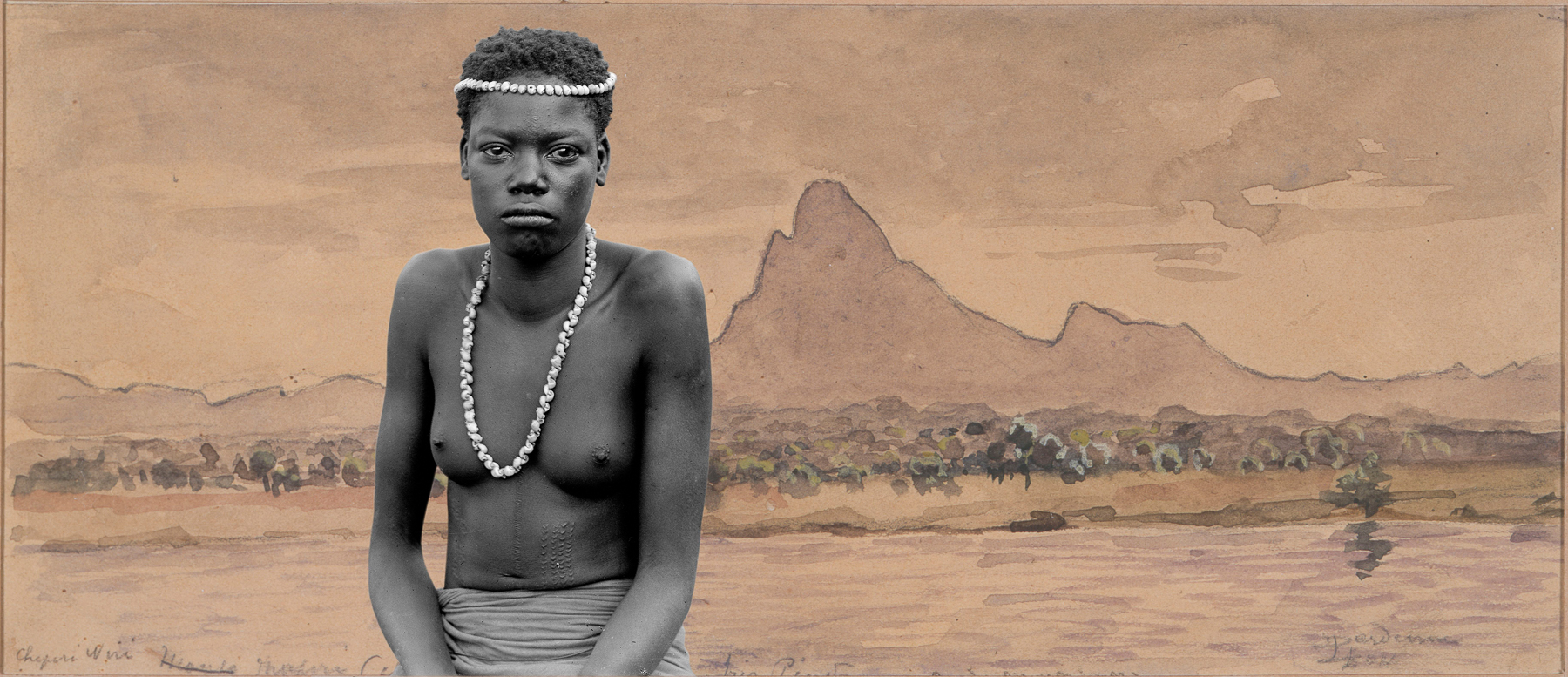
Sammy Baloji, Portrait # 2 Femme Urua sur fond d’aquarellle de Dardenne (Luba Woman Against Watercolor by Dardenne) from the series Congo Far West: Retracing Charles Lemaire’s Expedition, 2011. Digital photograph on matte Hahnemuhle paper, fifth edition; 39 3/8 x 91 inches. Collection of the artist. Courtesy of Axix Galery, New York and New Jersey.
The photograph of the Luba woman, now over a century old, is equally (if differently) “other,” both to its original European audience and to a contemporary indigenous descendant. She seems indifferent, both to the complex apparatus of the otherworldly nineteenth-century photographer and to the hyper-technologized, digitalized world of Baloji’s own photographic practice. Yet, despite her relatively affectless demeanor, she retains a powerful sense of presence, of being-in-a-place, that connects her own silhouette to the descending echo of the massif that stands behind her on the bank of the river, as if proclaiming, “I am I. And I am here. In this place. At this time.” Whatever her actual fate, her image endures—indexed, archived, and finally re-presented and re-contextualized—in Baloji’s contemporary work.
That this strategy also involves a critique of the colonial record and its recording methodologies (watercolor and ethno-photography) seems obvious. Taken individually, neither method provides us with an adequate picture of the country through which Lemaire and his expedition trekked. Nor, unless supplemented by text, would either have provided an adequate picture for the Belgian authorities in 1898. That descriptive function, of course, no longer exists; nor (indeed) does the world of the Congo Basin c. 1900. The images, however, do continue to exist, and can be used in any number of ways to any number of ends. In my view, Baloji’s appropriation of them constitutes both a critique de facto and an exploration of one among any number of potential reconfigurations and re-readings.
Every Thing Is Related
Earth Matters is an ambitious show, perhaps a bit overwhelming. But it comes by its ambition honestly, and in two ways. The first one is inherent in the subject matter itself: “Land as Material and Metaphor” covers an enormous amount of ground. It allows the curatorial team, for example, to juxtapose an exquisite nineteenth or early twentieth century Fang byeri figure from Gabon against Wangechi Mutu’s grotesquely logical Sprout from 2010,7 and the iconic Voortrekker landscape South West African Mountains (1944) by the Afrikaaner painter Jacob Hendrik Pierneef against both Wayne Barker’s 1989 Apies River, which uses over-painting in a Jean Michel Basquiat mode to deface and politicize landscape motifs replicated from Pierneef, and Graeme Williams’s implicit commentary on the fate of Peernief’s vision: the brilliant 2010 digital print The screen of the Top Star Drive-In Theatre on an old mine dump, Johannesburg, South Africa.8
The show’s second major complexity is more conceptual, and it brings into sharp focus something that should be recognized as axiomatic by contemporary Africanists, but which may be less obvious to a lay public like that characteristically addressed by the Fowler. In fact, it constitutes a major revision of African cultural history, a continuation of work begun in Paris at the groundbreaking exhibition Magiciens de la Terre in 1989.
According to that earlier cultural narrative, the history of African art can be divided into two distinct periods. The first can be characterized (inaccurately) as “pre-contact.” Its archive comprises indigenous artifacts that once would have been labeled as “tribal” or “primitive.” Although the process was a lengthy one, contact with non-African, especially European, culture inevitably and inexorably effaced and degraded Africa’s indigenous cultures to the point that artifacts, once nexuses of power, bearers of meaning, and records of history, became empty vessels recycled as beautiful objects of trade and markers of cultural inferiority.9
Eventually, however, as Western culture became increasingly global, the fundamental character of African art changed. It became caught up in the working out of the problematic of global modernism—theoretically, institutionally, and in terms of its own practice.10Indigenous culture remained, if at all, as a kind of patina, without much power beyond a simple affirmation of African otherness. The trade in denatured “tribal” artifacts, of course, continued.
In the exhibition Magiciens de la Terre, this narrative was attacked head-on, and not just with respect to Africa. Living contemporary artists from all over the world were exhibited side by side; all were identified by name (no more anonymous crafts-men and-women) and none were hobbled by subaltern or post-colonial status. Likewise, none was accorded an exalted or normative status like that traditionally granted to Europeans and their colleagues from the United States.11
Confining itself to Africa, the focus of Earth Matters is narrower, but deeper. Arranging its material thematically, it draws no distinction between anonymous indigenous artifacts12 and contemporary works by internationally celebrated artists across the whole spectrum of media. While never downplaying the cataclysmic ruptures that have riven African history (especially, of course, the slave trade and the extractive depredations of Western capitalism), it nevertheless grants to Africa both a geographical integrity stretching from the mouth of the Nile to the Cape of Good Hope, and a coherent and cohesive web of cultures that has endured disruption across time but that to a large extent has preserved core values and beliefs, even while thriving on appropriation and re-imagination, and has remained resilient and meaningful. Even in work that reflects a predominantly “pre-contact” rather than post-colonial worldview, we can see an enormous amount of inter-group borrowing, appropriation, and repurposing. In contemporary work, the quotations, citations, critical revisions, cultural collisions, crosscurrents, and interpenetrations are ubiquitous.
In theory, this is a brilliant strategy. In practice, however, it presents a serious historiographical and curatorial problem: the persistent opacity of African cultural traditions grounded in the predominantly oral transmission of deep cultural knowledge and the difficulties faced by ethnographers, anthropologists, and art historians in teasing out this knowledge in research situations may be fraught in any number of ways. Thus, while the catalog text makes clear that even the most crudely simplified figures (for example the wonderfully toy-like Bamana boli [an altar figure] produced in Mali) are embedded in complex matrices of cultural and cosmological meaning, it is sometimes hard to specify exactly what those meanings might be.13
Take binding for example. As we might well expect, many African cultures imbue the Earth itself with an autochthonous or deep-seated power, and this belief has informed the production of many of the indigenous objects in the show. Curiously, many of the figures that embody this sense of deep earthly power are bound—wrapped and tied with ropes or strings of various sorts. Taking it as one specific instance among many, consider a Tanzanian figure (most likely Zigua or Pare in origin) of a woman standing with legs apart and hands on hips. Originally considered as being associated with initiation ceremonies and the elaboration of ethical codes of behavior, these figures are now more often associated with ughanga, rituals of healing.14
In the latter case, the binding, easily seen encircling the figure in a complex pattern, might be associated either with the “binding up” of the body by evil spirits or negative influences, or with the binding of the body as a way of closing it off from these spirits or influences—that is, either with sickness (the effects of bad medicine) or with healing (the effects of good medicine). It has been further suggested that, in a similar way, the binding might reflect either the act of enslavement (a literal tying or chaining up) or the ties that bind an enslaved one to his or her home place or native Earth. Or, “As the healer Tate Habibu told [the art historian Robert] Thompson, ‘in uhanga every thing is related to everything else.’”15
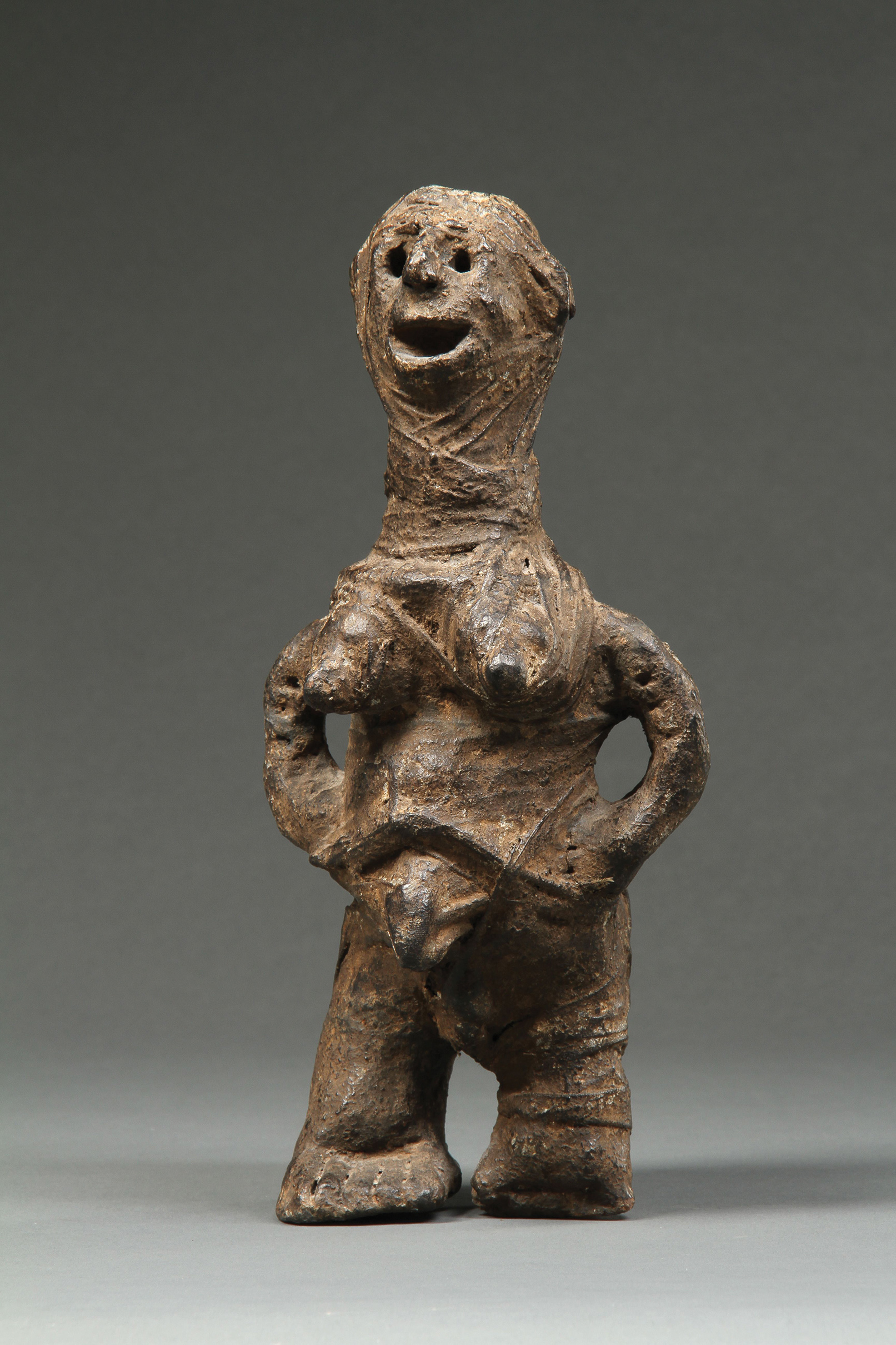
Pare or Zigua artist, Tanzania Figure, date unknown (most likely 19th to early 20th century). Terracotta, fabric, fibers, resin. Collection of Robert T Wall Family, W0450.
Finally, the organizers of the show have selected work by a range of artists that provides the widest possible definition of what it means to be “an African.” Again, without denying either the complex racial and ethnic politics operative in Africa today, or the fact of the global African diaspora that has scattered artists of African descent across the world-wide cultural landscape, they have presented an inclusive vision that is rooted not in race, but rather, in place. This is a show first and foremost about Africa—African soil, African land, African landscape—and the uses to which that soil and land and landscape have been put as men and women have struggled to mediate that complex relationship to the natural world that is so important to self-understanding and self-definition.
All of which returns us to a simple if central question: How is it, exactly, that the Earth Matters? It matters, following the thematics of the show, as an irreducible material thing (as soil, dirt, clay, mud); it matters as a source of power; it matters as the covering of, or the entrance to, an imaginary “underground”; it matters as a mappable skin stretched taut over those underground depths; it matters as a site for environmental action and as a site and material for the construction of Earth Works or Land art (as we would understand those terms in a Western cultural context). It undoubtedly matters in other ways as well, but what gives the exhibition its unique force is not its claim to a comprehensive breadth. Rather, it is the way that the chosen themes have been explored in depth, the way individual objects have been explicated, and the way in which connections between objects and their meanings have been woven, despite sometimes immense disparities, into shimmering and beautiful patterns.
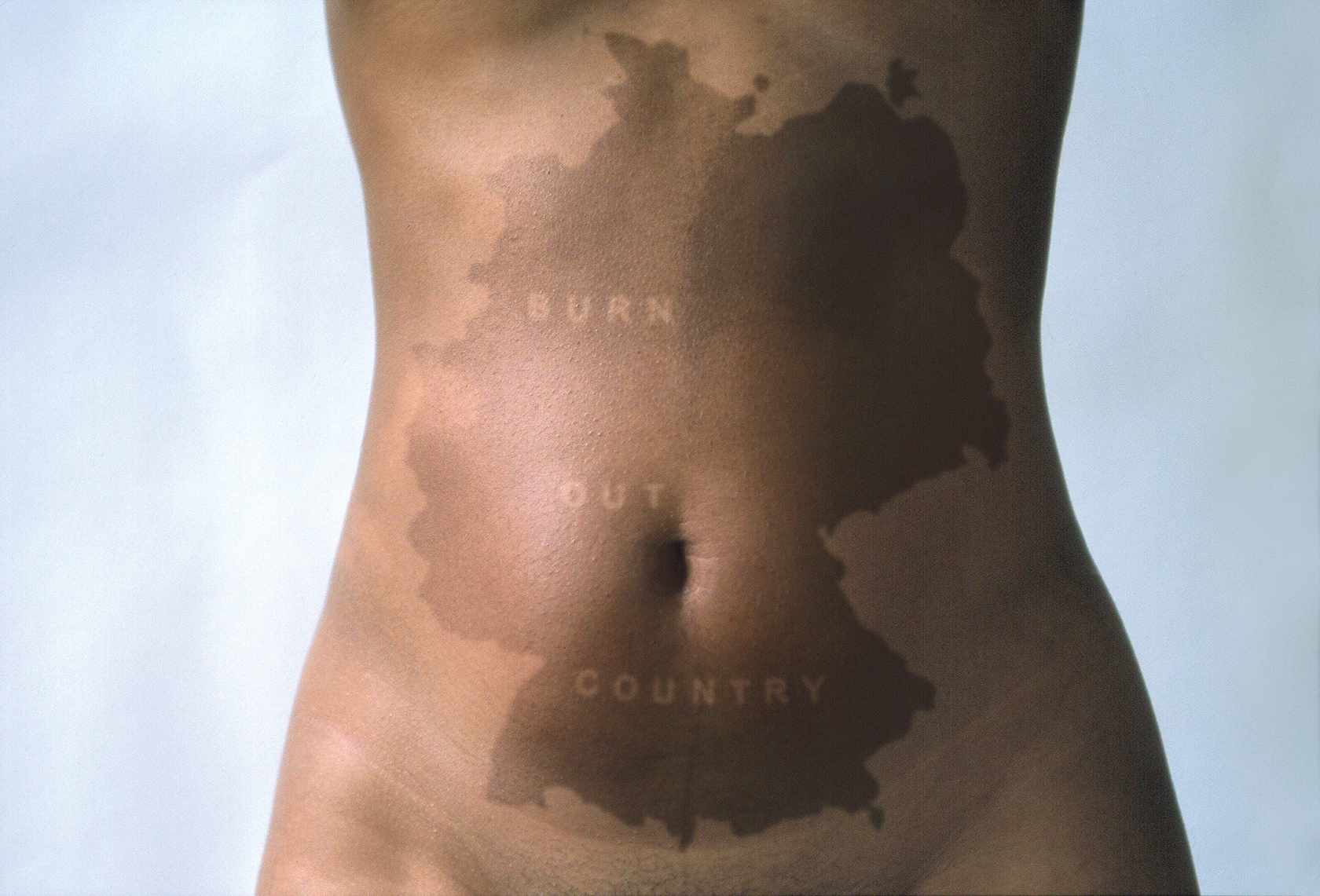

Mwangi Hutter, Static Drift, 2001. Two C-prints on aluminum (diptych), edition 4/5; 29 1/2 x 40 inches. Podesta Collection, Washington, DC.
Static Drift
In the Western cultural tradition, the gendering of “Earth” has generally been relatively straightforward. She is (ideally) feminine, recumbent, pliant, fertile, fruitful, flowering, and in all ways fecund. Among African cultures, things are not necessarily so simple. In Africa, Earth can be as easily gendered male as female; and the cycle of Nature’s seasons and their rootedness in the Earth may be actively performed, as in the do masquerade found among numerous peoples in Mali and Burkina Faso.16
At the same time, contemporary African artists often foreground Earth as a site of contest: both African bodies and African land have been caught in a web of colonial and post-colonial relationships that define a complicated web of meanings. This condition is beautifully and poignantly caught by the artist duo Mwangi Hutter (Ingrid Mwangi and Robert Hutter) in a diptych of chromogenic prints from 2001 entitled Static Drift.
Kenyan by birth, but with an African father and a German mother, Mwangi spent fifteen years living in Nairobi, where her father served as mayor. She now resides in Germany with her partner and artistic collaborator Hutter and their Afro-politan children. Mwangi is thus both dark (in Germany) and light (in Kenya), a child of the African diaspora yet with deep roots in African soil. In a sense, then, she is the product of two “Earths,” one associated with a colonial power, the other the object of that power’s appropriative greed.
In Static Drift, Mwangi Hutter gives us two fragmented images of Mwangi’s body, impersonalized and (largely) desexualized, but by no means disengendered. Her belly has become Earth’s fertile body, reduplicated and darkened as if by exposure to the sun so that we see it as the ground on which two maps have been stenciled. One photograph gives us an image of the whole of Africa, which seems to hover and shimmer above the surrounding darker “ground” (skin). Stenciled across this map is “BRIGHT DARK CONTINENT.” The inversion of the Western stereotype here is brutally pointed, but the image of the continent itself, by virtue of its shape, its careful placement, and its luscious color, is almost magically beautiful. Much less so is the dark and ill-shaped map of Germany on the other leaf of the diptych, which reads “BURN OUT COUNTRY.”
Clearly, the politics of post-colonialism are in play here. But this is obviously not a cut-and-dried lesson in colonial and post-colonial history. Rather, it is a demonstration, as intensely personal as possible (it is literally inscribed on the artist’s body) and yet much wider in its implications (the artist’s fragmented torso is impersonal, anonymous) of the fluidity of postmodern identity. The sense of rootedness, of home, of place, of “being somewhere” that has been so important to our modern sense of self, is called radically into question by Mwangi Hutter. The work speaks to the challenges of “belonging to” two Earths as radically different, both in the extent of their geography and the depth of their history, as Germany and Kenya, and it is powerful enough to critique that condition as well as describe it. In this way, the work enters easily into conversation with Bajoli’s Portrait #2, which also engages issues of personal presence alienated from place by both political and historical circumstance.

George Osodi, De money series no. 1, 2009. Fuji crystal archival print, 31 1/2 x 471/4 inches. National Museum of African Art, museum purchase, 2011-16-1.
De Money
Up to this point, most of the work considered here has dealt with questions of identity and belonging. These issues are very much a part of the exhibition, but so are issues that deal with ownership, expropriation, and exploitation. The Earth may be a source of political and spiritual power, but it is also a source of wealth, economic contest, and ecological depredation. Among the works that most directly and powerfully confront these conflicting yet deeply intertwined issues is George Osodi’s archival print De money series no. 1 (2009).
“De money” is how impoverished Ghanaians refer to the tiny nuggets and slivers of gold that they extract, at considerable physical risk, from illegal mines that gash the earth like great open wounds.17 As Osodi’s photograph makes painfully clear, they work like ants on sheer artificial cliff faces, where the golden color of the earth conceals the shiny metallic object of their relentless and never-ending search.
De money series no. 1 rewards careful, up close study. It first of all provides an extraordinary portrait of the wounded earth: the deep structure of its geology, the pockmarked surface of the cliff endlessly carved out, chipped, and pecked at by the miners.18 But thanks to its grid-like formal integrity, it also draws attention to the miners themselves. At first, they might seem interchangeable, like pieces on a squared-off game board; and indeed they must in fact seem precisely like this to the larger interests (corporate, criminal, governmental) who profit from their expropriated labor. But through Osodi’s lens, they also appear as individuals. Not types (however heroic) as in Millet’s Gleaners (1857),19 but men: sweat-stained, mud-splattered, and dust-streaked, all ranged around the focus of the figure in the rusty pants, whose pose, muscular physique, and clearly legible expression make him, if not a hero, then at least a heroic embodiment of the pride and the pathos bound up with their struggle for existence in a globalized market.
In addition to this coruscating image, Osodi is also one of the artists represented in the catalog by a personal essay illustrated with further examples of his work.20 Many of the powerful images are taken from groups of works in series that chronicle toxic sites of natural resource exploitation, like the oil and gas extraction in the Niger Delta. Osodi’s articulate essay reads like a mini-text summing up the whole exhibition. From its first lyrical paragraph, it moves easily from an image of “the earth, as science has made me understand [it],” to the idea of World as Nature, “the fact that there is a supernatural being that has created the world with the quest to make it a loving and a good place for all to live,” “the famous law of the conservation of matter and energy,” and the “vicious circle” of life, death, and decomposition. Like the exhibition, it moves between discourses that might at first glance seem incompatible, setting up tensions between indigenous and im- posed ways of perceiving, thinking, acting. Yet it does not attempt to resolve those tensions. Rather, it uses them to establish a base on which to build a vision that is also complex: rooted simultaneously in a sense of oneness with Nature and in the uniquely human ability to self-consciously articulate both that one-ness and its cultural other. Out of culture’s originating alienation comes the ability for reconciliation.
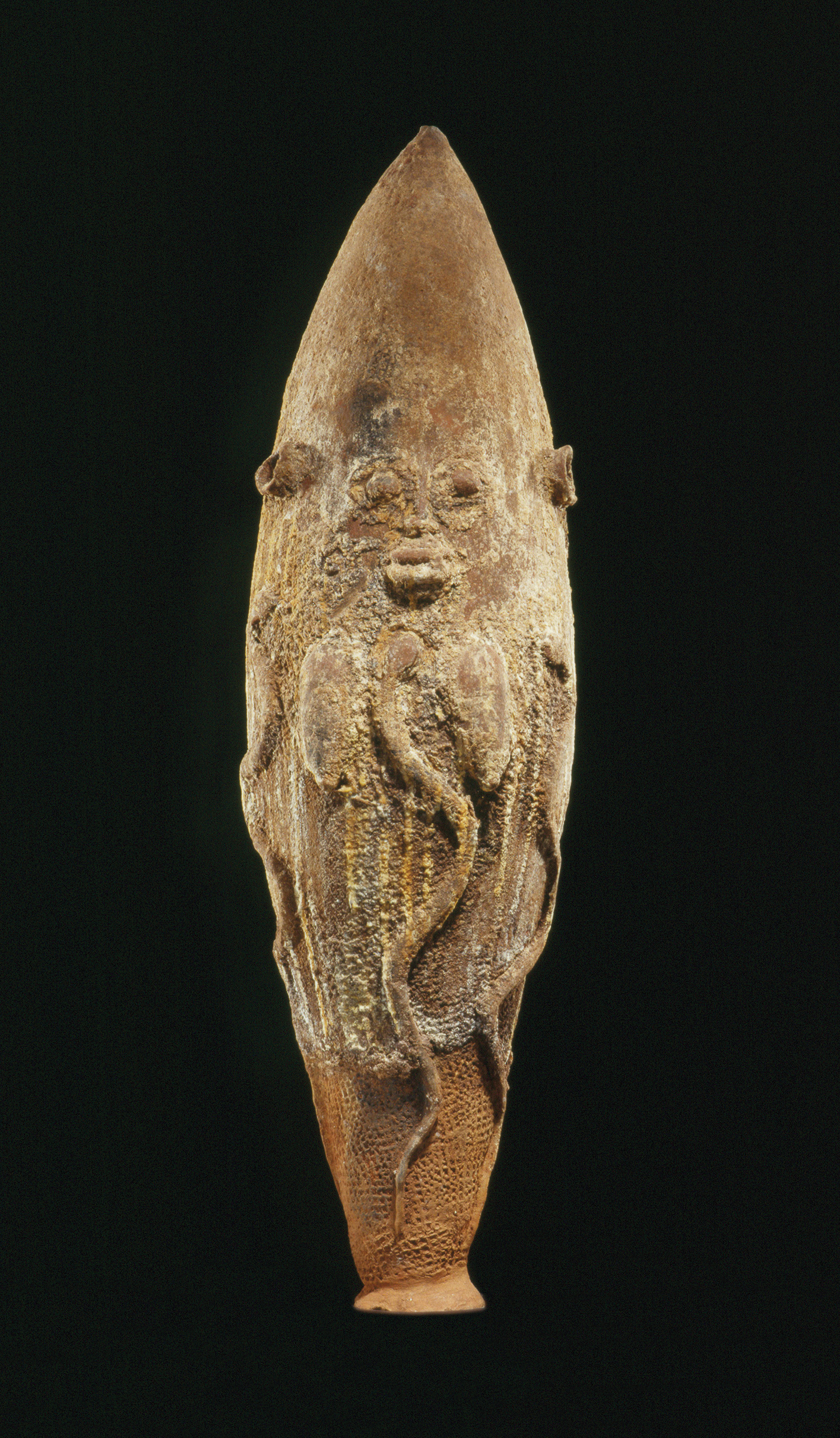
Oucatchi artist, Togo, figurative pot, early 20th century. Terracotta, 29 1/2 inches high. Afrika Museum, Berg en Dal, The Netherlands, 599-4
Ultimately, Earth Matters is rooted in the idea of place. That place might be as small as a village or as big as a continent seen from space.21 It might be conceived of as a surface, a site for dance or inscription. Or it might locate the site for a passage between worlds, for example providing West African followers of the vodun (spirits) with access to powers stretching from a realm deep underground up to the wide expanse of sky and sea overarched by the rainbow.22
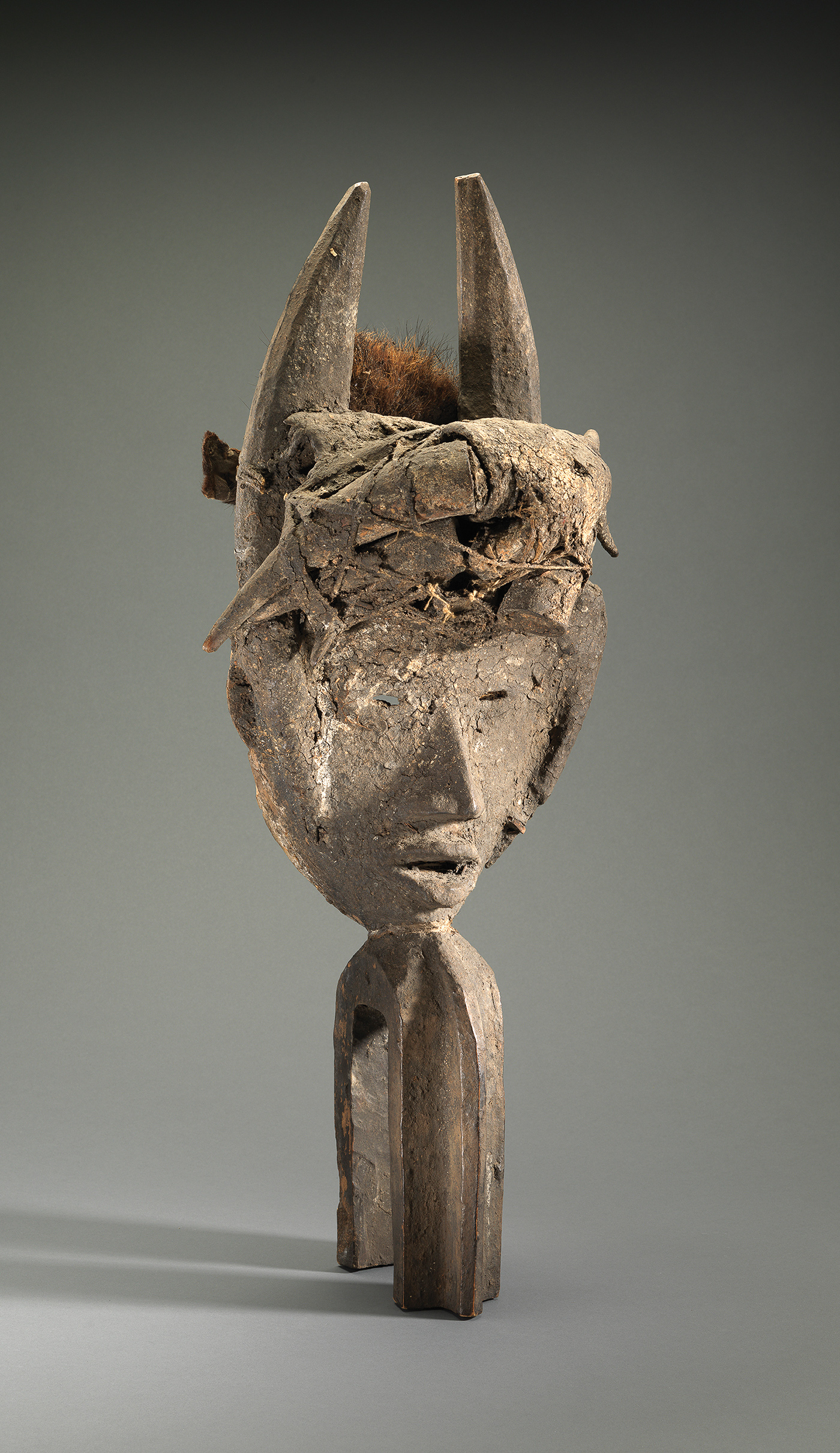
Mau artist, Côte d’Ivoire, possibly Komasu (male mask), early to mid-20th century. Wood, accumulative material, cloth, plant fiber, hide, horn, fur; 31 inches high. Courtesy of the Fowler Museum at UCLA and The Jerome L. Joss Collection. Gifrt of Mr. W. Thomas Davis.
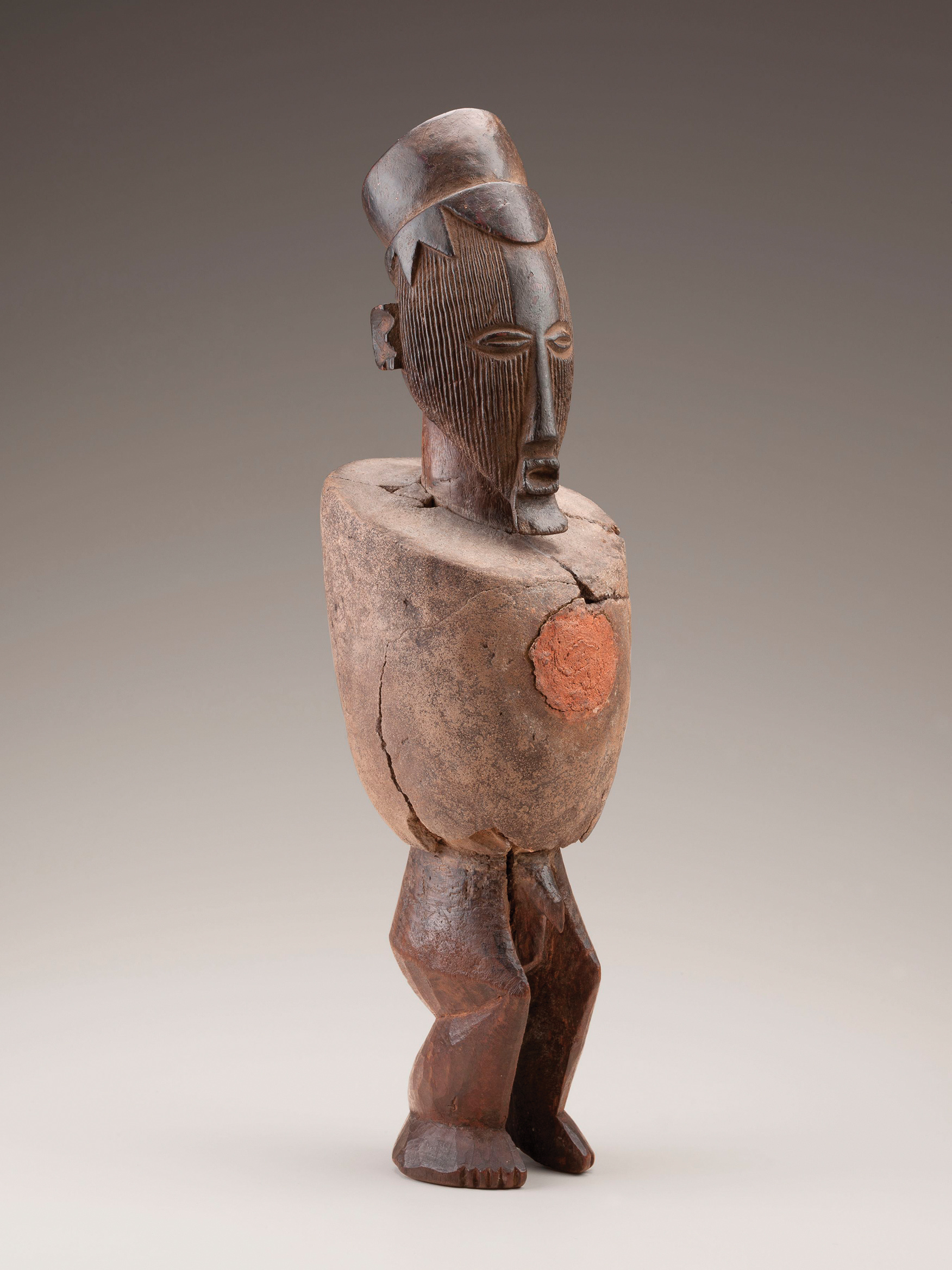
Teke artist, Republic of the Congo Buti or nkibi (healing figure), late 19th to early 20th century. Wood, accumulative material; 14 1/2 inches hight. National Museum of African Art. Acuisition grant from The James Smithson society and Museum purchase, 90-2-1.
The exhibition is rich with histories, cosmologies, and codes of behavior: competing and contesting narratives of indigenous integrity and appropriative globalization. This makes it by necessity an exhibition with no final resolution, an exhibition that raises at least as many questions as it answers. In that sense, Earth Matters is summed up in a photo by the Gabonese artist Owanto (born Yvette Berger in France in 1953 and now living and working in southern Spain). Owanto’s photo is a starkly beautiful shot of a wasteland in the sub-Sahara.23 Under a towering blue sky, resting almost on the flat horizon, what purports to be a simple road sign marks the intersection of two unpaved roads that snake across the surface of the desert. But rather than providing us with either location or direction, the sign poses a question in French, Owanto’s “native” language. It is in fact the guiding question of the exhibition: “Où Allons Nous?” Where are we going?
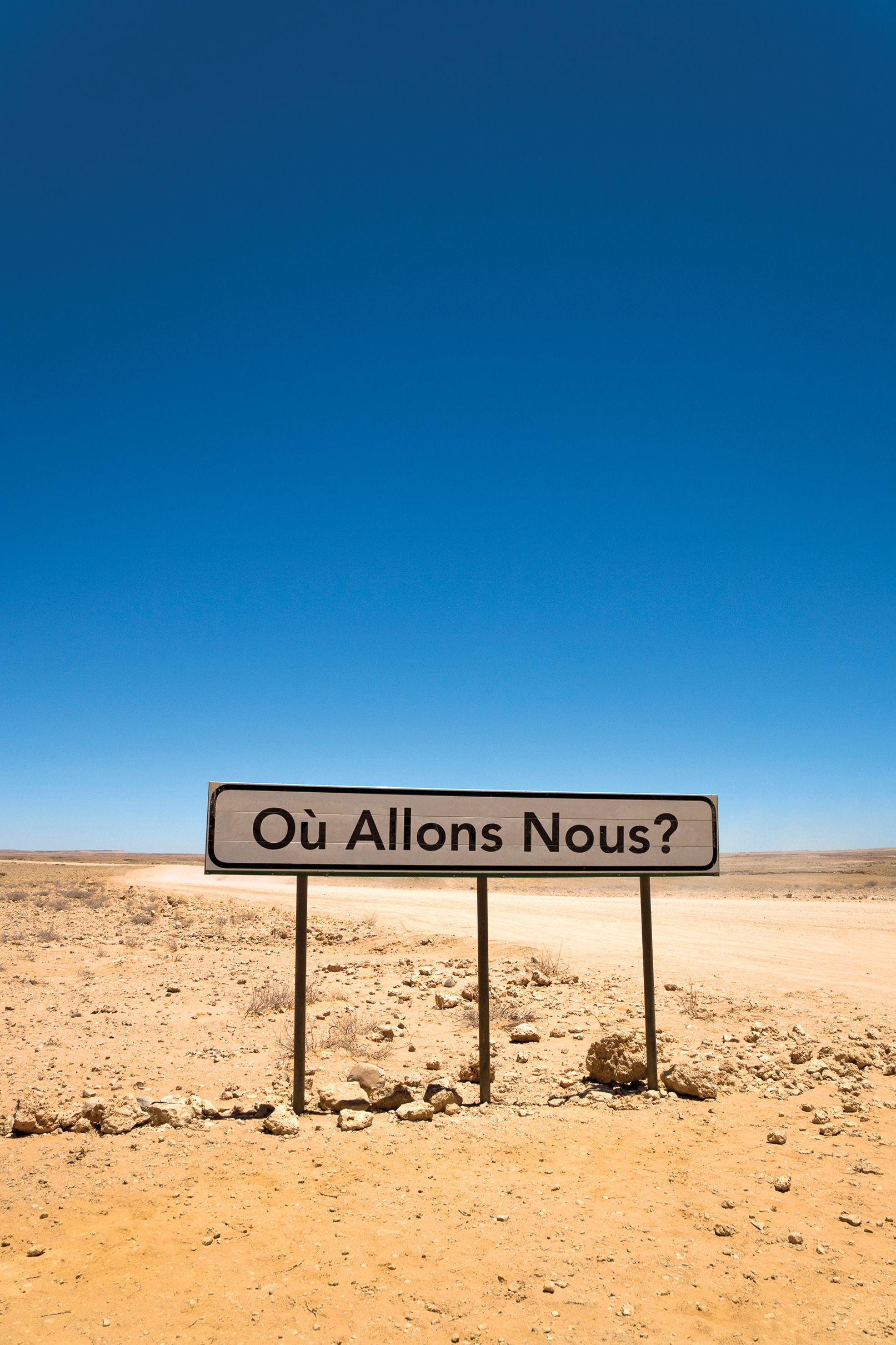
Owanto, Où Allons-Nous? (Where Are We Going?), 2009 (2013 exhibition print). Chromira print on archival paper, 59 x 39 1/3 inches. Collection of the artist.
Glenn Harcourt has a Ph.D. in Art History from the University of California, Berkeley. He lives and works in Pasadena.
